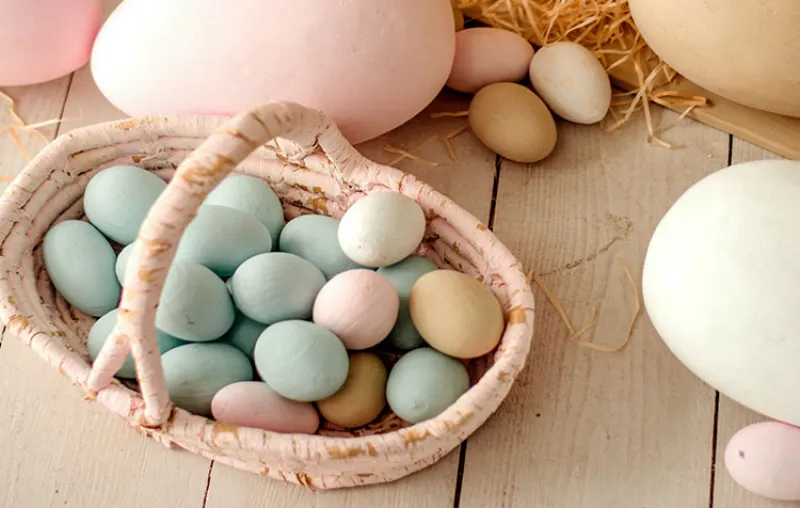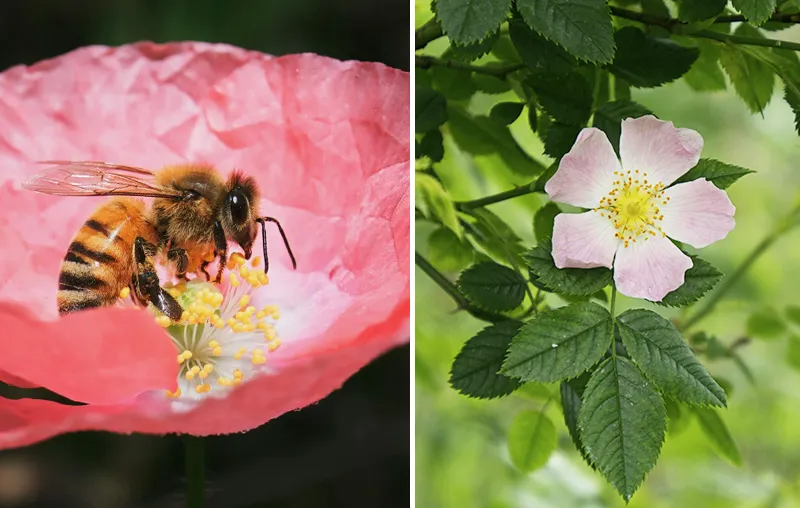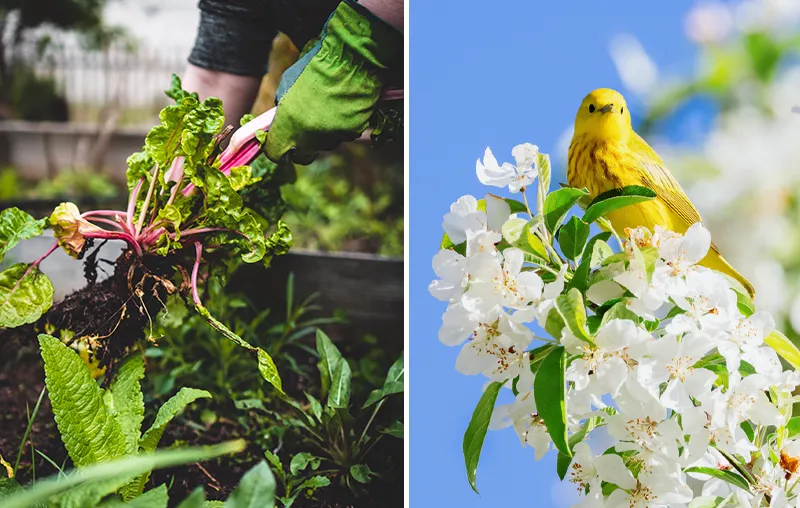Are you looking for trees for small gardens to provide a habitat for wild bees and other insects? Then you've come to the right place! Whether a garden is small or not is of course perceived differently by all of us. In the village, for example, even 500 square meters is considered small, while city dwellers consider a small garden to be 100 square meters or less.
But that doesn't really matter! Because in the end, it's all about understanding that you can make a big difference even in smaller garden spaces and that the Putting the brakes on insect extinction can. Small trees play a crucial role in this.
In this article, I would therefore like to introduce you to native, ecologically valuable and compact trees that wild bees, beetles, hoverflies, caterpillars and butterflies love. They are perfect for small gardens because they need little space and rarely grow over 10 meters tall! Let's go!
1. Common Hawthorn (Crataegus monogyna)
I'm an absolute fan of the meshed hawthorn (is available here*) because it is easy to cut and keep compact. And because with its beautiful white flowers in May and June attracts an incredible number of wild bees and numerous other insects to our small garden.
The insect-friendly small tree is available both with Tall trunk as well as somewhat bushier in the form of a Large shrub.
In addition, its dense, thorny branches offer many Garden birds a protective home, which is why it also works very well in Bird-friendly gardens fits
Key facts: Why is the invasive hawthorn so good for bee-friendly, small gardens?
- Insects: Important for wild bees, caterpillars, butterflies, hoverflies and beetles
- Height: about 3-6 meters high
- Width: about 3-5 meters wide
- Root system: Deep rooter
- Growth habit: Shrubby spreading to tree-like
- Where to buy? Here at the Horstmann nursery* or in the plant trade
2. Goat Willow (Salix caprea)
Native willows are the Insect magnets par excellencebecause they provide pollinators with nectar and pollen early in the year! I know of hardly any other tree that provides a habitat for so many different small animals. As the sal willow (is available here*) only one Height of up to 6 meters it is particularly suitable for small garden areas.
Decisive facts: Why is this Sal willow so valuable for insect-friendly, small gardens?
- Insects: Important for caterpillars, wild bees, butterflies, hoverflies and beetles
- Height: about 3-6 meters high
- Width: about 3-4 meters wide
- Root system: Shallow rooter
- Growth habit: Shrubby to tree-like
- Where to buy? Here at the Horstmann nursery* or in the plant trade
3. Plum (Prunus domestica)
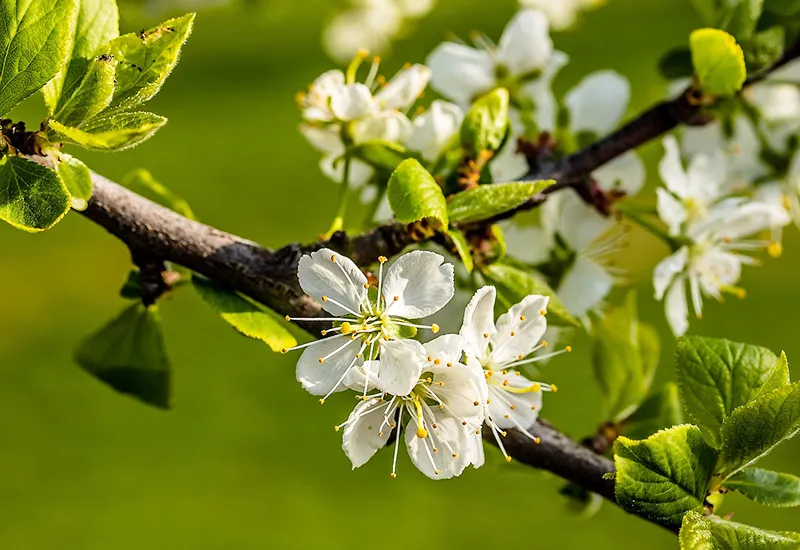
A must for everyone bee friendly garden is the plum or damson. (is available here*)
Wie viele Obstbäume wird sie not even 5 meters high and its branches grow quite compactly. There is enough space under the rounded crown for perennials, grasses and other garden plants.
Numerous insects love the small tree. Above all, however, wild bees enjoy the tree from April onwards. white flowers with a high nectar and pollen value.
As the native plum increasingly rare and is already on the Red List of endangered species, you can make a valuable contribution to the environment by planting it. Biodiversity perform.
Decisive facts: Why is the plum ideal for bee-friendly, small gardens?
- Insects: Important for wild bees, caterpillars, butterflies, hoverflies and beetles
- Height: about 2-5 meters high
- Width: about 2-3 meters wide
- Root system: Heart rooter
- Growth habit: Tree-like with trunk and slightly spreading crown
- Where to buy? Here at the Horstmann nursery* or in the plant trade
4. Field Maple (Acer campestre)
The field maple (is available here*) is a wild form native to Germany and a relatively compact, easy-care treewhich, in my opinion, is quite suitable for small gardens. Also because it doesn't grow so sprawling and is also very tolerant of pruning.
His green-yellow blossoms locken viele Wildbienen an, und auch die Leaves serve as food for many an insect. In addition, its dense crowns provide shelter and nesting opportunities for numerous bird species.
Decisive facts: Why is the field maple in particular so suitable for insect-friendly allotments?
- Insects: Important for caterpillars, wild bees, butterflies, hoverflies and beetles
- Height: about 5-15 meters high
- Width: about 5-9 meters wide
- Root system: Heart rooter
- Growth habit: Rounded to conical with standard trunk (often also multi-stemmed)
- Where to buy? Here at the Horstmann nursery* or in the plant trade
Alternatives: Is the field maple still a little too big for your garden? Then perhaps the native French maple (Acer monspessulanum) is something for you. Another suitable variety could be the globe maple (Acer platanoides "Globosum").
5. Mahaleb Cherry (Prunus mahaleb)
Until recently I knew the stonecrop (is available here*(also known as rock cherry or sour cherry). It is also only moderately common - above all it is a rarity in German gardens. It is a wonderful, insect-friendly small tree and is also extremely suitable for smaller gardens due to its compact size.
The small tree attracts with its white blossoms in spring attracts around 48 species of wild bees. Caterpillars, butterflies and many other insects also love it. The stonecrop is also one of the most important bird protection and feeding trees. bird-friendly trees.
Key facts: Why plant a stonecrop in a small garden?
- Insects: Important for wild bees, caterpillars, butterflies, hoverflies and beetles
- Height: about 3-5 meters high
- Width: about 2-4 meters wide
- Root system: Deep rooter
- Growth habit: Loose, shrubby spreading, to tree-like
- Where to buy? Here at the Horstmann nursery* or in the plant trade
6. Bird Cherry (Prunus padus)
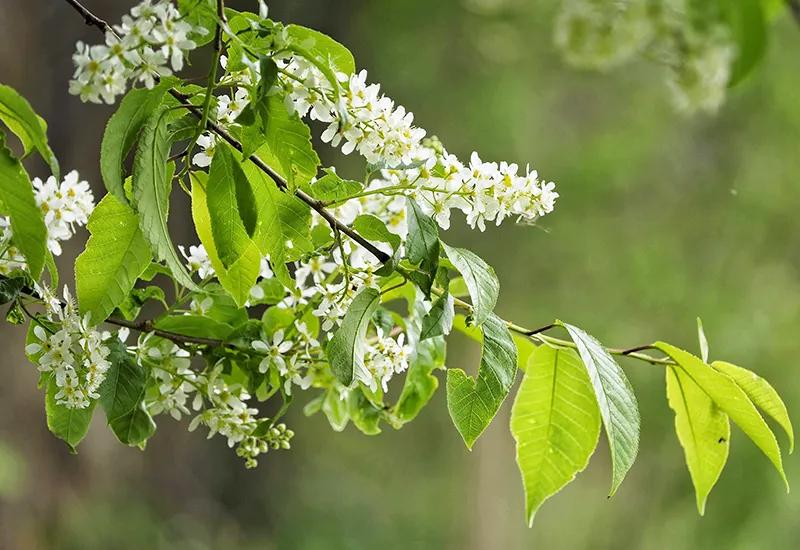
The common weeping cherry (is available here*) is also one of the insect-friendly small trees, as it can be combined with one or two Keep the cut in good shape lets.
Many caterpillars, butterflies and wild bees feed on the lush green leaves and white flowers in April and May. And over the dark drupes native bird species are also happy about this.
Key facts: Why does the common weeping cherry fit so well into the small, insect-friendly garden?
- Insects: Important for wild bees, caterpillars, butterflies, hoverflies and beetles
- Height: about 5-15 meters high
- Width: about 5-7 meters wide
- Root system: Shallow rooter
- Growth habit: Ovoid and tree-like with a fairly spreading crown
- Where to buy? Here at the Horstmann nursery* or in the plant trade
ATTENTION! Please do not confuse the small tree described with the late bunch cherry (Prunus serotina), which originates from North and Central America. It spreads rapidly, displaces native species and should be kept out of your garden. You can find out more in the article about invasive trees.
7. Blackthorn (Prunus spinosa)
Of course, my favorite blackthorn (is available here*also known as blackthorn) has crept onto this list of insect-friendly small trees. tends to be more of a shrubbut grows quite tree-like up to a maximum height of 3 meters.
Your numerous in the spring, white blooming flowers and their lush green leaves are a feast for wild bees and caterpillars of all kinds. Butterflies, flies, beetles and, last but not least, birds also celebrate the thorny, beautiful large shrubwhich, in my humble opinion, is an absolute must in every small garden.
Key facts: What makes blackthorn so valuable for the insect-friendly small garden?
- Insects: Important for wild bees, caterpillars, butterflies, hoverflies and beetles
- Height: about 2-3 meters high
- Width: about 2-4 meters wide
- Root system: Heart rooter
- Growth habit: Rather sparse, shrubby to tree-like
- Where to buy? Here at the Horstmann nursery* or in the plant trade
Tip: I have also provided you with a separate list of the most bee-friendly shrubs which also includes blackthorn. I like to take a look there.
8. Common Rock Pear (Amelanchier ovalis)
The common rock pear (is available here*) is a native and fairly small tree. It is a member of the rose family, is only a few meters high and not too wide. In April and May, the nectar- and pollen-rich white flowers attract wild bees in particular.
Verwechsle den kleinen Baum aber bitte nicht mit der Kupfer-Felsenbirne (botanical name: Amelanchier lamarckii), which is unfortunately more common in garden centers, but originally comes from North America.
Key facts: Why is the rock pear so suitable for small gardens with lots of insects?
- Insects: Important for wild bees, caterpillars and some butterflies, beetles and flies
- Height: about 2-5 meters high
- Width: about 2-4 meters wide
- Root system: Shallow rooter
- Growth habit: Loosely bushy, shrubby to tree-like (mostly multi-stemmed)
- Where to buy? Here at the Horstmann nursery* or in the plant trade
Good to know: Do you actually know, Why wild bees need to be protected - and not the honeybees? In the linked article you can find out the reasons for this in a nutshell!
9. Whitebeam (Sorbus aria)
Among the insect-friendly small trees, I also count the rowan (is available here*), which in Germany chosen as tree of the year in 2024 was. Why? Not only is it tolerant of drought and heat, it is also a beautifully flowering wild bee magnet.
It is so well suited to small gardens because it is quite grows compactly, is easy to cut and is not too tall. wird. Ich habe die Mehlbeere deshalb auch selbst im Garten. Mit seinen roten Früchten dient der Baum übrigens auch als wichtige Nahrungsquelle für Vögel – und zwar bis in den Winter hinein!
Key facts: Why does the rowan fit so well in bee-friendly, small gardens?
- Insects: Important for wild bees, caterpillars, hoverflies and beetles
- Height: about 4-15 meters high
- Width: about 4-7 meters wide
- Root system: Heart rooter
- Growth habit: Tree-like with standard trunk
- Where to buy? Here at the Horstmann nursery* or in the plant trade
10. Young's Weeping Birch (Betula pendula "Youngii")
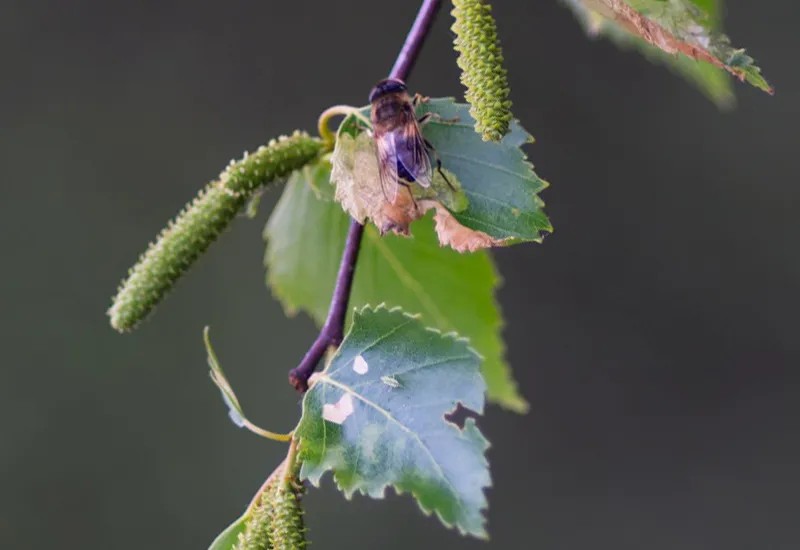
Die klassische Gemeine Birke bietet unfassbar vielen Insekten einen Lebensraum, kann allerdings bis zu 20 Meter hoch werden und ist damit wohl a little too large for most allotment gardens.
With the weeping birch (is available here*; it is a Variety of the native wild form), however, is a great one, more compact alternative ready. Birch branches hang elegantly from the small tree with its umbrella-like crown. Caterpillars, beetles and a few wild bees in particular appreciate the weeping birch as a habitat.
Key facts: Why does the weeping birch fit so well into an insect-friendly, small garden?
- Insects: Important for some caterpillars, beetles, hoverflies, butterflies and bees
- Height: about 4-7 meters high
- Width: about 4-6 meters wide
- Root system: Heart rooter
- Growth habit: Trunk, umbrella-like crown with hanging branches
- Where to buy? Here at the Horstmann nursery* or in the plant trade
Small Garden Trees with a Big Impact for Insects!
As you can see, we hobby gardeners can create a large garden even in a small space and with small trees, positive impact on biodiversity have. Here today you have learned about some trees that will help you do this - and at the same time provide a colorful, beautiful bloom in your garden.
"He who plants a tree, will win the sky."
Confucius (more at Quotes about trees)
There are of course many more Other insect-friendly small treeswhich also fit very well into gardens with little space - and which I don't want to withhold from you:
- Eared Willow (Salix aurita; 2-3 m high and 2-3 m wide)
- Upright Rowan (Sorbus aucuparia "Fastigiata"; 5-8 m high and 2-3 m wide)
- European Wild Apple (Malus sylvestris; 5-15 m high and 4-6 m wide)
- Rowan (Sorbus aucuparia; 8-15 m high and 3-7 m wide)
I hope that this article has inspired you and that you will soon be able to use these small yet extremely insect-friendly trees to Sounds of nature how the Enjoy the humming and buzzing simply by following your heart.
Falls dich jetzt das Naturgarten-Fieber gepackt hat, muss ich dir zum Abschluss unbedingt noch das Buch "Wild & colorful: Designing natural gardens with native plants" von Simone Kern mit auf den Weg geben. Wenn du magst, get it here*.
Do you have any questions, suggestions or do you know of any other trees for small gardens? Then I look forward to your comment!
Stay close to nature,

PS: Do you want to do more for small animals? Then take a look at my next Instructions for building a beetle cellar on. Alternatively, a Sandarium for earth-nesting wild bees be an exciting DIY project for you! Good luck!



